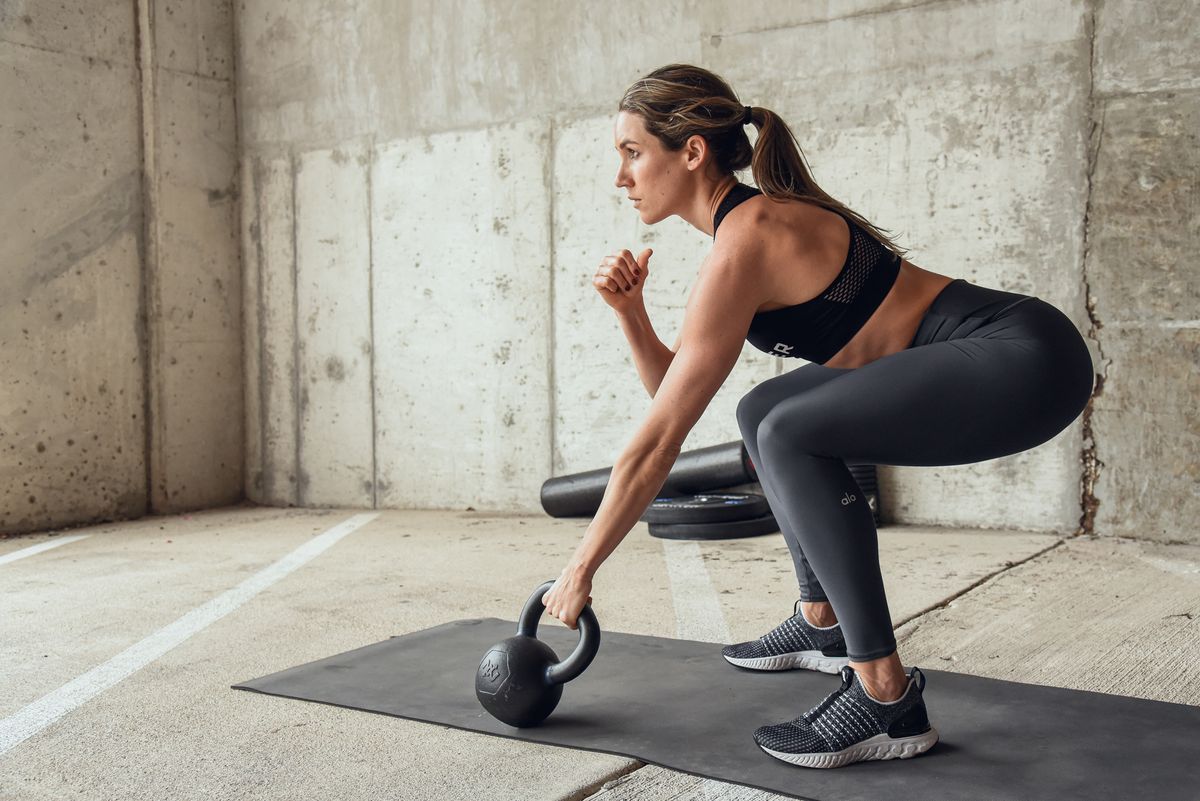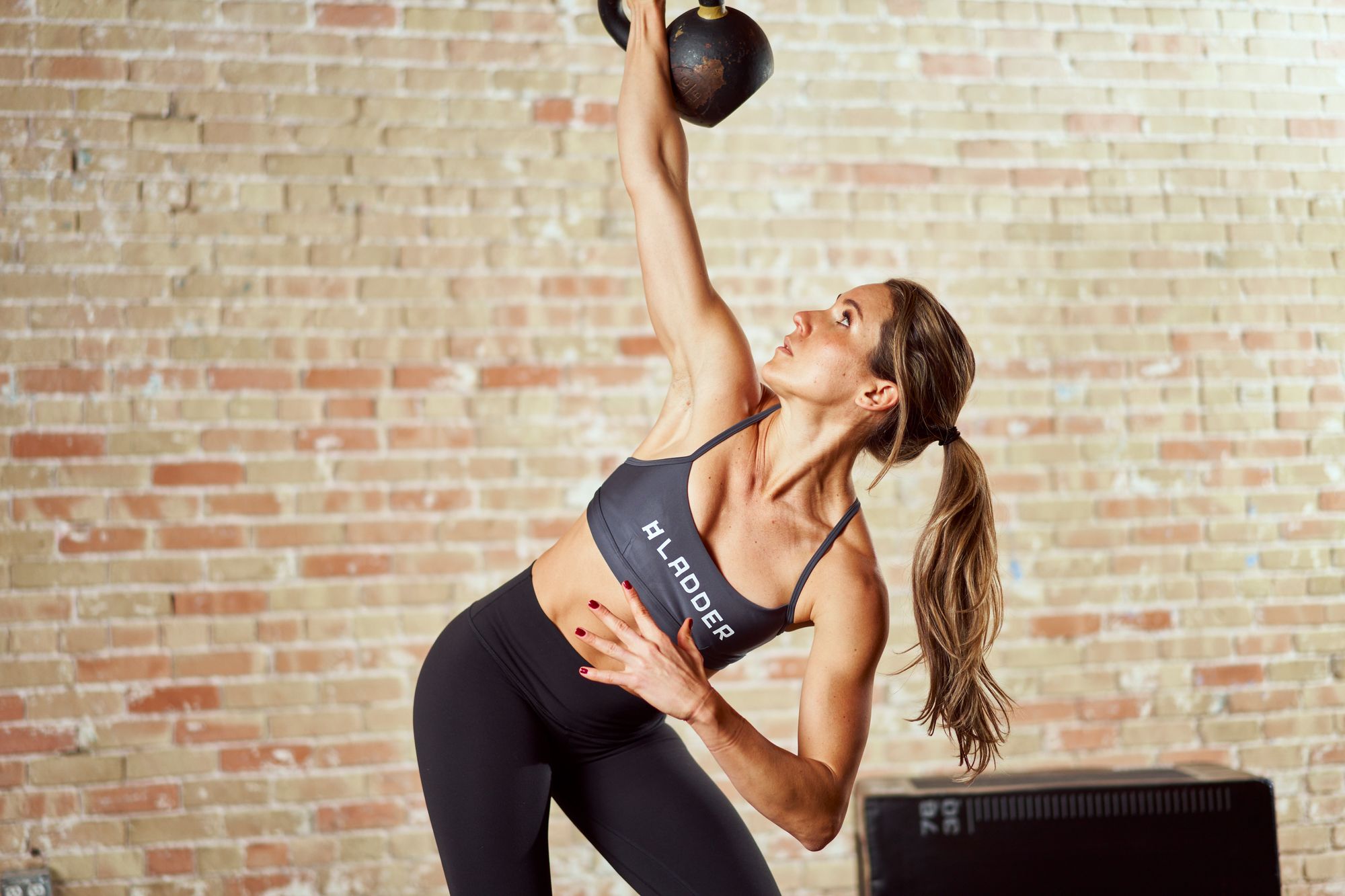How to Do a Turkish Get-Up? (with video demonstration)

Master the Kettlebell Turkish Get-up Step-by-Step, and Avoid Common Mistakes and Injuries.

Lauren Kanski
Ladder Senior Coach, CPT

Turkish Get-up Introduction
As a kettlebell-focused strength coach, one of the most common questions I get asked is what is a Turkish get-up? The kettlebell Turkish get-up is one of the most useful training exercises ever developed. It was designed to improve strength, mobility, stability and coordination.
In this article and in my Turkish get-up video demonstration, I’ll show you how to perform a Turkish get-up step-by-step while avoiding common mistakes that can lead to injury.
Turkish Get-up Demonstration (audio & video)
Step-by-Step Instructions for the Turkish Get-up
The Turkish get-up kettlebell exercise is fundamental to kettlebell training. I’m going to teach you how to master each of the five core movements that make up the Turkish get-up.
Step 1:
Start by lying down on your right side in the fetal position. You’re going to have the horns of the kettlebell in your right hand, and your left hand on top of your right knuckles.
Step 2:
Hug the bell into your chest and roll over onto your back facing the ceiling. Bring the kettlebell on top of your chest with both hands.
Bring your feet into a half starfish position so that your right leg will be bent, and your left leg is out at a 45 degree angle.
Press the bell up above your chest with both hands, then release the left and hold it alone in your right hand. With your knuckles punched through the roof, squeeze the bell nice and tight. Retract your scapula by pulling your right shoulder blade against the floor.
Your left hand will extend out off your shoulder at about a 45 degree angle, and your thumb should be in-line with your hip.
Step 3:
Use the heel of your right foot and your core to drive the kettlebell up and across your body onto your left forearm.
With your eyes on the kettlebell the whole time, you are going to press from your left forearm to your left palm.
Step 4:
You’ll then do the “sweep” which is where you bring your left knee in-line with your left palm, about 6 inches behind it, so that your hips are at a perpendicular angle.
This is known as the WINDMILL movement.
Then you are going to shift your weight into your right hip. Bring your hips forward into extension. Then you’ll spin the back leg so it’s parallel with your front leg, in the half kneeling position.
Step 5:
Tuck your back leg’s toes and use them to propel you up to standing at the top of the get up, YAY! But you aren’t done, let’s go back down the same way we came up.
Step 6:
This is known as the OVER HEAD REVERSE LUNGE or the REVERSE GET UP.
Let your toes guide you back into the lunge, then spin your back leg so that your hips are perpendicular again.
Then you are going to sit into your right hip, and slide your left hand down your left thigh to guide you into the position to plant your hand about 6 inches off your knee.
Shift into that hand.
Step 7:
Sweep your left leg through and bring your butt down to the floor, and then you'll go down to your forearm.
Step 8:
Slowly lower or fight your way back down to the starting position which is on the floor.
Turkish Get-up Mistakes That Lead to Injury
The Turkish getup is a great exercise that will challenge and strengthen your whole body. However, there are some important things to keep in mind when performing this exercise to avoid injury.
Here are a few quick tips for you to avoid any potential back and shoulder injuries that could happen when you're doing this move:
1. Watch the bell over your head the entire time, this will help you stay balanced.
2. For the initial ascent off the floor, remember to drive with your bent legs heel so you use your hips and not your core.
3. Your toes guide you, keep them tucked and in contact with the floor when in the sweep and the lunges at the top of the Get Up.
4. Don’t forget to breathe!! Move nice and slow!
5. There are many steps and puzzle pieces to the Turkish get-up, as it’s technically many exercises combined into one. Focus on one piece at a time and then progressively link them together. Start unloaded with your body weight or a shoe or yoga block over head also work well.
The Benefits of the Turkish Get-up
The Turkish get-up is a single-arm kettlebell exercise that works a variety of muscles, targeting the shoulders, core, hips and lower body. While the movement is designed to be performed with a kettlebell, it can also be done with a dumbbell. The movement isn’t often taught in gyms, but it can help you improve your posture, increase your mobility and build total-body strength. With some practice and effort, you'll be rewarded with strength and more proprioceptive awareness (your spatial awareness).
The Turkish get-up workout is a fundamental movement in kettlebell training because it is so unique. It is the only exercise where your body fixes a load and then moves around it in different ranges of motion. The skills required to perform these movements will enhance your athletic development and performance.
How to Incorporate the Turkish Get-up Into Your Workout Routine
The Turkish get-up is a great way to improve your strength, coordination, mobility and most importantly, your health. If you are looking to create a more challenging workout, incorporating the Turkish get-up into your training routine will not only help you strengthen your core but also help improve your balance and flexibility. The best part about this exercise is that it combines other movements like deadlifts, squats, crunches and presses.
The Turkish get-up is an exercise that should be done in low volume and reps, usually at the beginning or end of a workout for maximum benefit. The Turkish get-up is also a rehabilitation exercise; it has been successfully used to help people recover and prevent shoulder injuries.
The Turkish get-up can seem extremely overwhelming at first, but be patient with yourself! The good news is that it doesn't take years of practice to master this exercise. With the right training plan, it's possible to learn the fundamentals of the movement in just three to four weeks.

Lauren Kanski
Ladder Senior Coach, CPT
Lauren is a Senior Coach at Ladder, a NASM-certified personal trainer, nutrition coach, Women’s Health Advisor, and published fitness writer based in New York City. Lauren’s online training program, BODY & BELL, available exclusively on the Ladder app, features daily full body workouts with a focus on kettlebell skills development and progressions.

